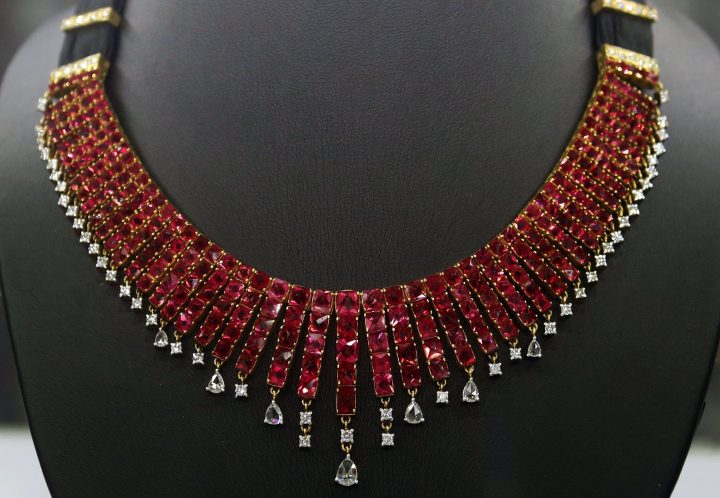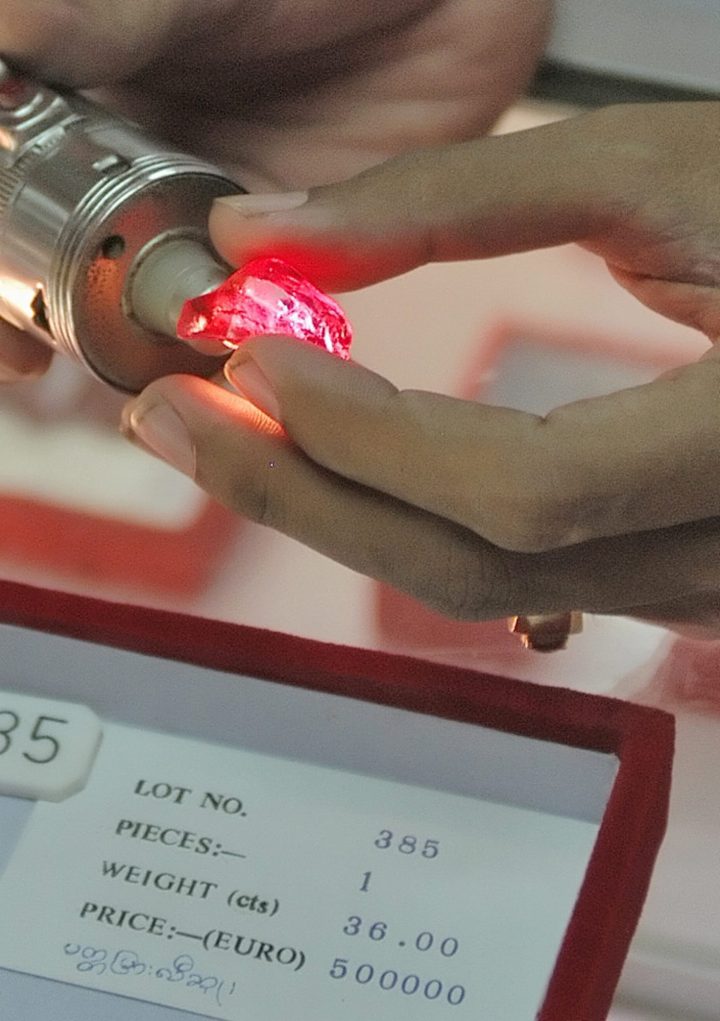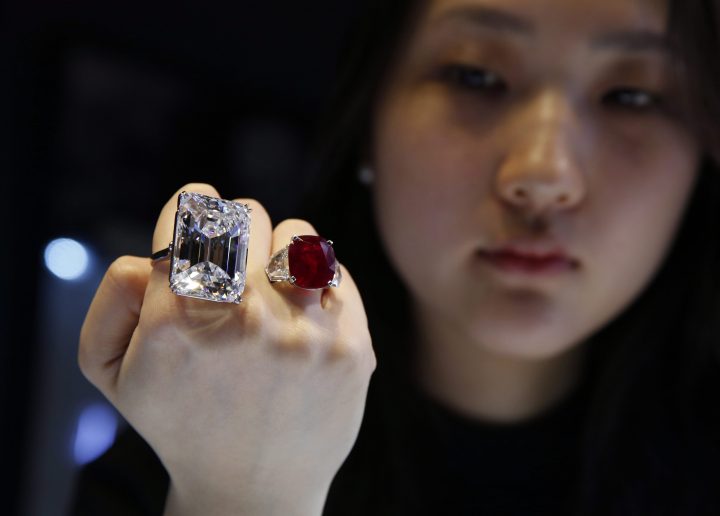Jewellers have made it easy to buy a diamond while keeping your conscience clean. They’ve adopted a passport system showing the origin of every stone, so you can be sure that your hard-earned money isn’t funding a brutal militia in a historically conflict-torn nation such as Angola, Sierra Leone or the Democratic Republic of Congo. If you don’t want a blood diamond, you can be certain you’re not buying one.

But for those who prefer the rich colour of a ruby or a sapphire, it might keep you up at night to learn the profits from Burmese gemstone sales may be going to a military regime that the United Nations accuses of genocide.
The U.S.-based International Campaign for the Rohingya (ICR) is calling for shoppers to boycott so-called “genocide gems” from Myanmar this holiday season, in hopes of punishing the military regime that killed thousands of ethnic Rohingya people last year. The regime has a major stake in the gemstone trade through its two large holding companies, which help Myanmar produce approximately 90 per cent of the world’s high-end rubies, along with some of its priciest sapphires. Myanmar also produces massive quantities of jade for China.
China imported an estimated $31 billion worth of jade from Myanmar in 2014, according to a report by Global Witness. Myanmar’s gross domestic product in 2014 was US$65.45 billion, according to the World Bank.
Most of Myanmar’s Burmese rubies and sapphires are smuggled into Thailand to be cut and sold on the international market, multiple industry experts told Global News.
United Nations trade data from Myanmar and Thailand shows the two nations reporting very different export and import numbers with one another over several years. For instance, Thailand reported bringing in US$4.7 million worth of uncut precious and semi-precious stones from Myanmar in 2016, while Myanmar reported sending over just $1.8 million worth of stones. Thailand has not provided data for 2017, but Myanmar claims to have exported $106,539 to its neighbour last year.
Thailand was the second-highest exporter of rubies to the U.S. by weight (310 kilograms) in 2014, and the highest exporter by value ($59 million), according to data from the U.S. Geological Service. Thailand did not produce any ruby from its own mines in 2014, according to the USGS annual industry report. USGS data for Myanmar shows it produced 486,945 kilograms of ruby in 2014.
“Professionals in the trade know that nowadays, Thailand doesn’t produce rubies,” said Montreal-based gemologist Odile Civitello.
“If you see jewellery that says ‘made in Thailand’ or ‘made in Hong Kong,’ those gemstones could come from Myanmar,” said Erin Murphy, an industry consultant and former gemstone advisor in the Obama administration.
Myanmar used to be known as Burma, and its most coveted gemstones still use the name. Burmese rubies and sapphires can fetch up to eight-figure prices through high-end auctions and online jewellery retailers. Most gems come with a lab-test certificate showing which country they come from, but these certificates often don’t say which company profited from their sale.
In other words, luxury retailers putting up $100,000 Burmese ruby rings may be reselling a gem sourced from a military-linked mine, and customers would never know.
Myanmar accused of genocide
ICR organizers say boycotting gems from Myanmar is an effective way to punish the military for its violent campaign against the Rohingya, an ethnic group of approximately 1 million Muslims. Myanmar’s government has persecuted the Rohingya for over four decades, denying them citizenship, refusing to let them vote in elections and launching multiple campaigns to push them out of the country.
WATCH BELOW: Myanmar leaders accused of ‘crimes against humanity’

The ongoing struggle hit a breaking point last August, after a small faction of Rohingya militants killed 12 security officers. The Myanmar military responded with a swift, brutal and large-scale campaign to wipe out Rohingya villages in Rakhine state. The military killed an estimated 6,700 Rohingya during the campaign, according to an estimate from Medicines Sans Frontieres. More than 727,000 Rohingya fled the country into neighbouring Bangladesh, where they’ve lived in refugee camps ever since, the United Nations reports.
WATCH BELOW: Rohingya woman says she was raped in Myanmar

Several nations, including Canada and the United States, have sanctioned Myanmar’s top military leaders in response to the crisis. The UN has called for those leaders to stand trial for genocide — an accusation the military has denied.
How can I spot a ‘genocide gem’?
ICR organizer Simon Billenness says these “genocide gems” are the new “blood diamonds,” because any Burmese gemstone purchase may profit a business linked to Myanmar’s military.
Myanmar’s military controls two of the country’s four major mining companies, the Myanmar Economic Corporation (MEC) and the Union of Myanmar Economic Holding Ltd. (UMEHL), according to a comprehensive industry report from 2016. However, their opaque supply chain makes it very difficult to know which mine a Burmese gem came from.
ICR’s campaign echoes the decades-old fight against so-called blood diamonds, also known as conflict diamonds. A conflict diamond is any diamond purchased from a war-torn country where the profits go toward funding the armed conflict.
Jewellers, non-government organizations and several nations responded to the outcry over blood diamonds by developing the Kimberley Process in 2000. The system establishes a passport for every diamond, so jewellers can demonstrate exactly where their product was mined and cut. The Kimberley Process website claims to have stemmed 99.8 per cent of the global production of conflict diamonds.
The same mine-to-market process does not exist for coloured gemstones.
Civitello says a jeweller with a good Burmese gem will happily tell you where it’s from, because that’s part of its appeal. Top-end gems will also come with a certificate showing that they’ve been verified in a lab. However, smaller gems don’t always come with their full documentation.
Civitello says it’s difficult to say how many Burmese gems are in the North American market, but most of the gems in the U.S. and Canada are from Africa. Burmese gems are often the centrepieces of luxury rings, necklaces and earrings sold by some of the world’s most prominent jewellers.
There are several sources of rubies in the world, including Sri Lanka, Mozambique, Vietnam, Australia, Nepal and Madagascar. However, Burmese rubies are prized above all others for their deep red “pigeon’s blood” colour, she said.
The only way to be certain about a gem’s origin is to have it tested at a gemological laboratory, “although it’s quite difficult because some other rubies in the world might have similar characteristics,” Civitello said.
Second only to diamonds
Myanmar claims to produce approximately 90 per cent of the world’s high-end rubies. However, an estimated 60-80 per cent of Myanmar’s gems are exported outside the formal system, so it’s difficult to fully grasp the size of the industry, according to a 2016 report by the Extractive Industries Transparency Initiative in Myanmar. The world’s coloured gemstone industry is worth approximately US$12 billion annually, according to the report.
The most valuable non-diamond ever sold at auction was the 25.59-carat Sunrise Ruby from the Mogok Valley, which fetched US$30 million at auction in 2015. Cartier set the ruby in a ring before it sold the gem through the Sotheby’s auction house. The sale took place before Cartier committed to stop sourcing gems from Myanmar in late 2017.
Civitello says rubies and sapphires are more popular in the Asia-Pacific region than in North America or Europe. However, data shows their popularity is growing.
The American diamond market is roughly 10 times larger than its coloured gemstone market. Nevertheless, coloured gemstone imports grew by 23 per cent from 2016 to 2017, while diamond imports dipped by three per cent, according to the U.S. Geological Service. The U.S. imported approximately $2.5 billion in gemstones for consumption in 2017.
Most of Myanmar’s gemstones are smuggled out to neighbouring Thailand or Hong Kong to be processed, according to Erin Murphy, who studied the industry closely as an advisor for the U.S. government in 2016. Murphy visited Myanmar in 2016 after the U.S. lifted a 13-year ban on imported jade and rubies from the country.
“If you have a high-quality gem, and it’s a ruby, especially the pigeon’s blood rubies … it probably came from Myanmar,” she said.
She added that jewellers often stock up their gemstones for years, so some jewellers might have Burmese gems in their collection even after they’ve committed to stop buying more.
Billenness says some jewellers circumvented the U.S. ban by buying their Burmese gems through Thailand. Those are the jewellers he’s trying to target.
Who is selling Burmese gems?
Billenness is planning to protest against the Italian jeweller Bulgari this holiday season, in hopes that its parent company, LVMH Moet Hennessy Louis Vuitton, will commit not to purchase gems mined from Myanmar. Bulgari’s “Diva Dream” line currently features a necklace and ring made with Burmese sapphires, according to its website. Bella Hadid wore both items to the Cannes Film Festival last year.
ICR launched a similar campaign against Bulgari last year, prompting the company to say in December that it does not buy gems “in Myanmar.”
“All coloured gemstones used by Bulgari are purchased from internationally recognized auction houses through established international markets. Bulgari stipulates that its suppliers comply with its code of ethics,” the company said in a statement issued in January.
Bulgari said it “firmly condemns any kind of violence,” and that it’s not aware of any new international sanctions on Myanmar since 2016. “Myanmar’s civil government is undergoing a deep political and economic transformation to a democratic state,” the company said.
The company declined to comment on the renewed pressure campaign to Global News.
“We believe that individual and non-coordinated private initiatives from non-official institutions, rather than helping solve some potential issues, may backfire creating other issues such as illegal trading and further poverty,” it said in January. Bulgari added that it is part of the Responsible Jewellery Council and a participant in the DragonFly Initiative, a sustainable advisory firm that includes several other top jewellery brands.
Bulgari previously joined several other luxury brands in boycotting Myanmar gems in 2007.
ICR successfully convinced Cartier to stop selling Burmese rubies and sapphires last December after an ICR campaign that accumulated more than 150,000 petition signatures pushed it to do so.
“As part of our continuous review process to ensure ethical sourcing, Cartier has decided to stop purchasing gemstones from Myanmar,” the company said in response to a Facebook comment from Billenness.
“Cartier will not purchase certified goods from the country, and will make its best effort to ensure that non-certified gemstones did not originate there.”
Billenness says he was pleased by the “very early success” of the Cartier campaign, and he sees no evidence of Burmese gems in its current lineup. He hopes Bulgari will commit to stop selling Burmese gems as well.
Billenness says he hasn’t identified any other major jewellers that appear to be dealing in Burmese gems. However, the stones are still readily available through various online auction sites.
Murphy says there were still plenty of Burmese gems on the U.S. market during the last round of sanctions, because jewellers often store their gems for years before using them in a ring or necklace.
She adds that Billenness’ boycott campaign probably won’t hurt the Myanmar military, because it makes most of its money through exporting jade to China.
Supply chain ethics
Most major jewellers try to adhere to ethical supply chain policies but fall short of international standards, according to a 2018 Human Rights Watch report that examined gold and diamond sources for 13 top European brands. The authors found that “almost none” of the jewellers could trace all of their components back to the individual mines where they originated. The report did not analyze gemstone sourcing practices, but it did recommend jewellers put a chain of custody in place “for all precious metals and gems, including diamonds.” HRW also recommends jewellers publish the names of their metal and gem suppliers on an annual basis.
“While some companies are actively working to identify and address human rights risks in their supply chains, others rely simply on the assurances of their suppliers,” the report authors wrote.
Tiffany & Co. received the only “strong” rating in the report, for taking “significant steps toward responsible sourcing.” Bulgari, Cartier, Pandora and Signet received “moderate” ratings for taking some important steps. Boodles, Chopard, Christ and Harry Winston were rated “weak” and Tanishq was rated “very weak” on their sourcing practices.
Tiffany & Co. and Pandora welcomed the report in separate statements to HRW. Bulgari and Chopard pointed out that they follow industry-wide ethics standards. Signet accused HRW of using language “chosen more to criticize our industry rather than provide constructive recommendations.” The company said it emphasizes transparency and protecting human rights through its Signet responsible sourcing protocols, which are mandatory for all of its suppliers.
Boodles said it has relied on its suppliers to identify and mitigate human rights issues, and acknowledged that it could do more to ensure its suppliers are “sourcing materials in an ethical and sustainable manner.”
Cartier declined to comment. Harry Winston, Christ and Tanishq did not respond to requests for comment, HRW says.
Tiffany & Co. stopped buying Burmese gems in 2003, after the original U.S. gemstone ban was imposed. Tiffany’s says it has not purchased gemstones from Myanmar since then, according to its latest sustainability report.
International and citizen sanctions
Murphy says most North American and European jewellers have been hesitant to deal with Myanmar since the 13-year U.S. ban on its products was lifted in 2016.
The late Senator John McCain and Democratic Senator Ben Cardin co-sponsored a bill last year to re-impose those gemstone sanctions as punishment for the Rohingya crisis. The Burma Human Rights and Freedom Act received bipartisan support in the U.S. Senate, although it hasn’t been passed into law. The latest version of the bill was modified to ban only jade imports, and not rubies.
Billenness hopes his campaign will convince jewellers to be more transparent with their supply chain, regardless of whether it impacts the Myanmar military’s profits.
“It is possible, with some effort, for the jewellery companies to not buy genocide gems in Burma,” he said. “They just have to be really clear on where the gems were mined and where the gems were cut.”

















Comments